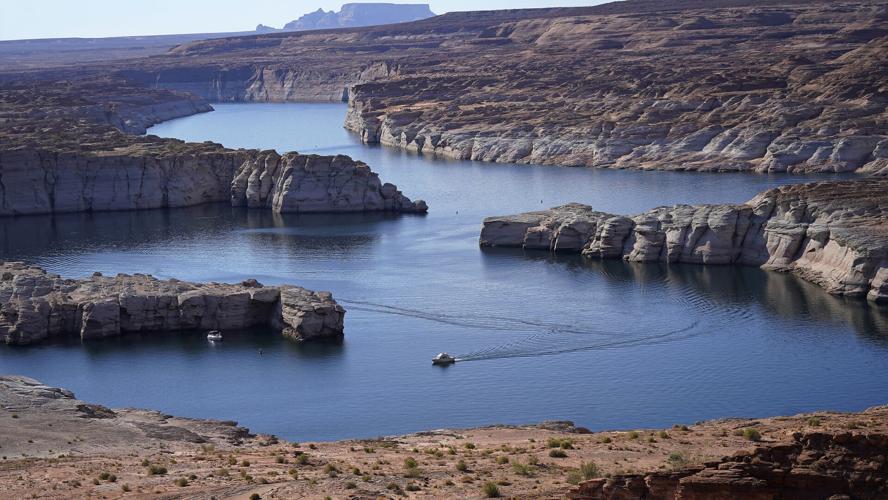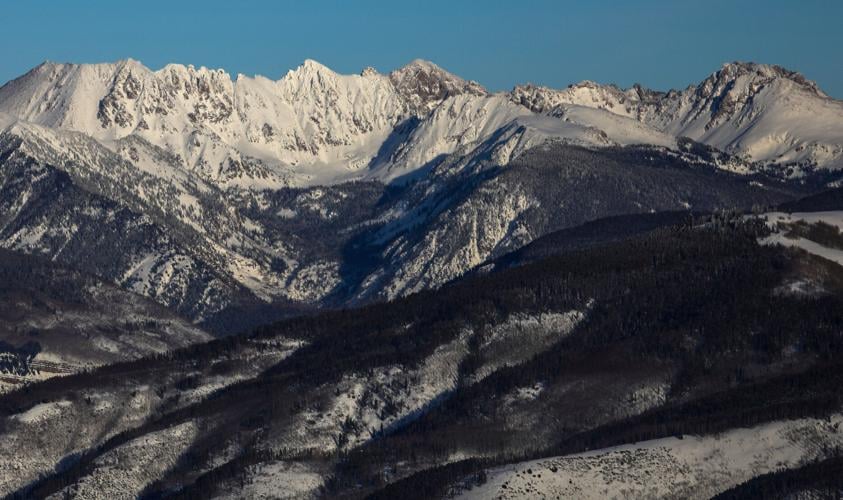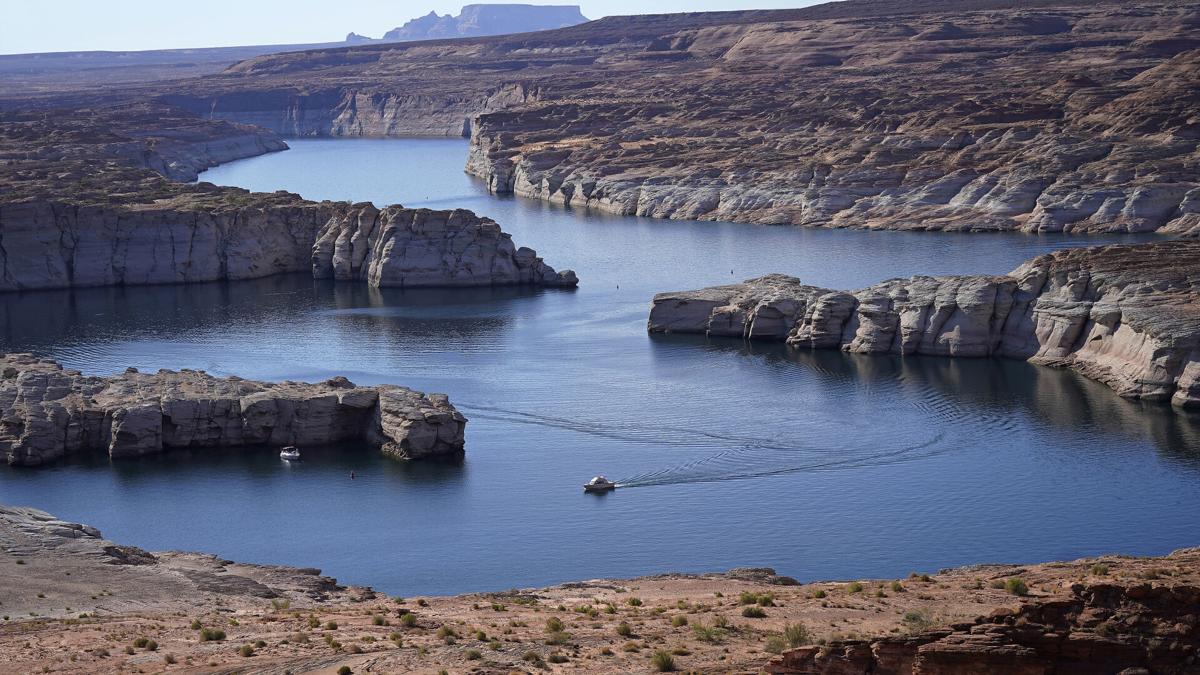This year’s spring-summer runoff into Lake Powell is set to be the highest since 2011, but a top Arizona water official won’t say if that will mean an easing of cuts in Colorado River water use proposed for 2024.
An official from Southern California’s Metropolitan Water District said, however, that this year’s runoff has been so good, computer modeling shows no additional cuts are needed beyond those already approved in past agreements to keep Lake Mead from falling below 1,020 feet, or 50 feet lower than where the lake is expected to stand at the end of 2023.
California water officials still plan to pursue cuts of about 400,000 acre-feet in use starting next year, said the Metropolitan Water District official, Bill Hasencamp. The district is a wholesale water agency, selling water to municipalities and water districts in six counties including Los Angeles County.
Environmentalists and some scientists have been concerned for a few months that the good runoff will cause the states and federal government to “kick the can down the road,” by delaying any major cuts in river water use. They note that one good year doesn’t end the river’s long-term drought, and that it’s likely this year’s conditions won’t be repeated very often in the future.
Some state officials, however, have said that while the river’s long-term outlook remains bleak or at least troublesome, this year’s massive runoff will “buy time” for state and federal negotiators to work out longer-term solutions and to avoid drastic, immediate cuts.
States close to agreement
The river’s Lower Basin states of Arizona, California and Nevada have in recent weeks been moving closer to an agreement over how hard any cuts will hit each state starting next year.
A source familiar with the negotiations told the Star late last week that an agreement is not only close at hand, but that an early draft has been sent to U.S. Interior Department officials for their review, although negotiators in the three states haven't yet settled on all the terms. He asked that his name not be used due to the sensitivity of the negotiations.
Water officials from the three states and officials of the U.S. Bureau of Reclamation and Interior, its parent agency, met in Phoenix Wednesday in their latest round of negotiations.
“Everything I’ve heard from the states is that they expect to come up with a plan and the cuts will be in proportion to what’s required by the plan,” said Eric Kuhn, an author, water researcher and former general manager of a Colorado water district. ”Any plan put forth will be based on water availability. I think they’ll be prepared for a drier year next year. If it’s not a drier year, the cuts won’t be as dramatic.”
But no one involved in the talks has been willing to provide any details of what’s now being discussed.
Besides the question of how big of a cut each state would take starting next year, the other unknown is whether the cuts will be scaled back due to this year’s high runoff.

The Gore Range was coated with snow in Beaver Creek, Colorado, in January. Some of that snowmelt reaches the Colorado River.
Lake levels rising
Following three extremely dry years on the river, the April-July runoff into Powell is now predicted by the federal Colorado Basin River Forecast Center to hit about 11.2 million acre-feet, or 172% of the 1991-2020 average. That’s more than what flowed into the lake during the runoff seasons for the last three years combined.
The 2011 spring-summer runoff, the highest since the river’s 23-year period of aridity started in 2000, was about 12.5 million acre-feet. By comparison, the Central Arizona Project canal system delivered about 1 million acre-feet last year to Tucson, Phoenix and other cities and farms in Southern and Central Arizona. An acre-foot is enough to serve about four Tucson households for a year.
Because of the expected high runoff, the Bureau of Reclamation now plans to release 9.5 million acre-feet of water this year from Lake Powell to Lake Mead, bureau official Dan Bunk said Friday at a briefing in Phoenix on possible CAP shortages for 2024.
That’s 2.5 million acre-feet more than was released from Powell last year. A few months ago, officials were expecting to release about the same amount from Powell this year as last, or about 7 million acre-feet, Bunk said.
Powell is now expected to end 2023 at about 3,568 feet elevation, more than 40 feet higher than it is today. Mead is expected to rise nearly 20 feet by year’s end, to 1,068 feet.
Mead is now 29% full and Powell is 24% full, but both reservoirs are expected to reach 35% full by the end of 2023, Bunk said.
Looking past this year, however, officials see a lot of uncertainty when it comes to reservoir levels, he said.
“Not to say for certain we will have a dry year next year, but that’s what happened (after wet years) in ‘99, 2011 and 2019,” Bunk said. “We have to keep that in mind as we move forward.”
The Interior Department released a draft supplemental environmental impsct statement last month on the river containing two alternatives for cutting river water use.
The two differ in how much water would be cut from Arizona and California, respectively. But each alternative would end up cutting about the same amount of water in total: Up to nearly 2.1 million acre-feet in 2024 and up to 4 million in 2025 and 2026. The amount of cuts would depend on how high or low Lake Mead sits at the end of each year.
The rain hasn’t ‘saved us’
At the Friday briefing, Arizona Department of Water Resources Director Tom Buschatzke declined to say if he thinks those cuts can be scaled back now because this year’s runoff has been so good.
With a May 30 deadline set by the federal government for public comments on the proposals outlined in the draft environmental report, he said, “all is still much in progress. The comment period will allow people to comment. I’m not going to comment on the path forward right now.”
But he said “it’s really important to note” that the federal environmental report based its analysis and proposals on “last year’s hydrology, which was not reflective of the better hydrology that we are enjoying this year.”
“We don’t want to squander that hydrology by saying that the rain has saved us. It’s not the case. We could go right back down if we don’t do things to hopefully protect Powell and Mead,” Buschatzke said at the briefing, held at CAP headquarters.
In the ongoing negotiations among the river basin states, “we’re looking for a more desirable outcome than under either action alternative” suggested by the Interior Department, he added. “We want this to be as collaborative as possible. We want to take advantage of the good hydrology, not squander it.”
Hasencamp, speaking from Metropolitan’s Los Angeles office, said he believes that when runoff into the Colorado from tributaries lying downstream of Lake Powell are added in, this year’s total runoff into the river is likely to be the wettest in 25 years.
“That’s a game changer for the short run. Obviously the long term still has problems, but in the short run, the modeling we’ve done indicated we need no additional cuts to get through the short run period” ending in 2026, the year the federal operating guidelines for the river expire, he said.
“That doesn’t mean we will do nothing,” said Hasencamp, the Metropolitan district’s Colorado River programs manager.
California water officials are moving ahead with already made pledges to cut their water use by 400,000 acre-feet next year, in return for compensation with federal funds, he said.
Southern California’s water agencies don’t all have signed contracts in hand to carry out the savings, but draft contracts exist for all the agencies involved and the hope is that all the contracts can be wrapped up in the next few months.
In Arizona, federal officials and CAP officials have agreed to plans for about 260,000 acre-feet in cuts from Arizona users that will be compensated by federal dollars. Additional cuts that have already been approved in earlier drought plans will bring the state's total water cuts this year to nearly 900,000 acre-feet, officials say..
On Thursday, the CAP’s governing board approved plans to compensate various Arizona water users for 183,000 of the 260,000 acre-feet worth of cuts starting this year. One participant in those cuts is the city of Tucson, which has agreed to cut its CAP deliveries by 50,000 acre-feet this year and 30,000 acre-feet in 2025 and 2026.
Phoenix has agreed to cut its CAP use by 50,000 acre-feet a year all three years, and Metro Water in Tucson’s northwest-side suburbs has agreed to take 5,000 acre-feet a year in CAP cuts in all three years.
"It's a very diverse group of entities stepping up the to the plate, protecting the system and protecting ourselves as well," Buschatzke said.
If all these contracts for the newest round of cuts are signed, it’s likely you’ll have (at least) 600,000 acre-feet to add to Lake Mead, on top of shortages already approved, Hasencamp said.
“Those are some pretty big numbers. The question is, is that enough? If we can commit those conservation efforts the next four years, will that satisfy the federal government? That’s the hope.”
Author-researcher Kuhn said he doesn’t believe the river basin states will or should back off water use cuts next year due to this year’s weather.
“Look what happened after 2011,” which was wetter than this year but followed by more drought years, Kuhn said. After a wet 2019, 2020 brought the first of three very dry years on the river, he added.
“I’m not saying next year is going to be a drought, but we need to be better prepared for it,” said Kuhn, formerly of the Colorado River Water Conservation District in Glenwood Springs.
David Wegner, a retired Bureau of Reclamation engineer and an environmentalist, said he would prefer to scale back the cuts in terms of the timing that they're implemented.
"The (supplemental environmental report) is just a stepping stone," to when the states and feds must agree on the longer-term operating rules for the river and reservoirs, he said.
"If as a result of this big water year, the impacts are not quite as bad as they might have been , that might give them more flesxibility," said Wegner, who now serves as a volunteer member of a National Academy of Science water and technology board. " -- that is the real challenge out; there. The challenge is how to get there."
But "why would you sit around and let another year go by?" countered former U.S. Interior Secretary and Arizona Gov. Bruce Babbitt.
"We get the point. What these guys are presumably saying is, 'That gives us more time, we have 3 years to reach an agreement. We're not losing anything by taking another year or two to reach agreement. The rising lake has postponed the real trigger, whatever it is,'" Babbitt said. "My response is sure you can stall around. You’ve got some extra time to stall around.
"It isn’t going to get easier to reach an agreement if they keep kicking the can down the road. Next year is an election year. Think about it. All the modelling for the SEIS (Supplemental Environmental Impact Statement) has been done. The facts are all in."
The basin states should act like this year's runoff never happened, added John Weisheit, director of the Utah-based environmental group Living Rivers.
"I’m not happy at the high runoff because it will create complacency. The scientists have told us we would get high water years; but overall we have a huge reduction due to climate change,” Weisheit said.
“What is most disappointing in this (federal environmental) document is that there’s nothing in it to address the climate crisis. No ambassador from the Colorado River Basin is going to the U.N. and saying, ‘We need to fix this thing, and we’re here to help’. I’m just getting so sick and tired of these people for not doing the right thing.”
Longtime Arizona Daily Star reporter Tony Davis talks about the Colorado River system being "on the edge of collapse" and what it could mean for Arizona.






